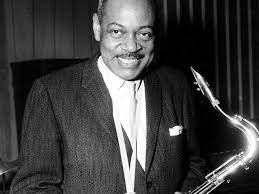Early Life and Education
Coleman Randolph Hawkins, known as the “Father of the Tenor Saxophone,” was born on November 21, 1904, in Saint Joseph, Missouri. His parents, both of whom were musicians, fostered his musical talents from a young age. Hawkins began piano lessons at the age of five and switched to the cello by the age of seven before finally settling on the tenor saxophone at the age of nine. His early music education continued at Topeka High School in Kansas, where he also studied harmony and composition.
Early Career
Hawkins’ professional career started when he was still a teenager. At the age of 18, he joined the Mamie Smith Jazz Hounds and began to make a name for himself. His tenure with the Jazz Hounds allowed him to tour extensively, giving him exposure to a wider audience and honing his skills as a saxophonist. By the mid-1920s, Hawkins had moved to New York City, where he joined Fletcher Henderson’s orchestra. This was a pivotal move in his career, as the Henderson band was one of the most prominent African-American orchestras of the time. Hawkins’ innovative and robust sound on the tenor saxophone soon became a defining feature of the band’s performances.
Rise to Prominence
Throughout the 1930s, Hawkins’ reputation continued to grow. His 1934 recording of “Body and Soul” is often cited as one of the most influential jazz recordings of all time. This performance showcased his technical prowess, emotive playing style, and ability to innovate within the framework of jazz standards. The recording was notable for its improvisational brilliance and has been studied by jazz musicians for decades.
European Sojourn
In 1934, Hawkins decided to broaden his horizons by moving to Europe. He spent the next five years performing in various countries, including England, France, and the Netherlands. His time in Europe allowed him to collaborate with many of the continent’s top jazz musicians and further cemented his status as a leading figure in the jazz world. This period also helped Hawkins refine his style and introduced European audiences to the rich, complex sound of American jazz.
Return to the United States
Hawkins returned to the United States in 1939, where he found that the jazz scene had evolved in his absence. Undeterred, he reestablished himself quickly, forming his own bands and continuing to perform and record prolifically. His influence was particularly strong in the bebop movement, which was gaining momentum at the time. Hawkins worked with many of the younger bebop musicians, including Thelonious Monk, Dizzy Gillespie, and Max Roach, and his ability to adapt to the new style further solidified his place in jazz history.
Later Career and Legacy
The 1950s and 1960s saw Hawkins continue to perform and record extensively. He appeared at major jazz festivals, including the Newport Jazz Festival, and collaborated with a new generation of jazz greats such as Miles Davis, Sonny Rollins, and John Coltrane. Despite the changing trends in jazz, Hawkins remained a significant figure due to his versatile playing style and willingness to embrace new ideas.
Hawkins’ influence on the tenor saxophone and jazz as a whole cannot be overstated. He transformed the tenor saxophone into a leading instrument in jazz and paved the way for future generations of saxophonists. His ability to blend technical skill with emotional depth made his music timeless and has inspired countless musicians across various genres.
Personal Life and Death
Coleman Hawkins was known not only for his musical talent but also for his intellectual curiosity and sophisticated demeanor. He was an avid reader and had a deep appreciation for classical music, which often influenced his jazz compositions and improvisations.
Hawkins’ health began to decline in the late 1960s, and he performed less frequently as a result. He passed away on May 19, 1969, in New York City, leaving behind a legacy that continues to resonate in the world of jazz. His contributions to the development of jazz saxophone and his innovative approach to improvisation have ensured his place as one of the true giants of jazz history.
Conclusion
Coleman Hawkins’ career spanned over four decades, during which he continually evolved as a musician and maintained his relevance in the ever-changing landscape of jazz. His pioneering work on the tenor saxophone and his profound influence on the bebop movement highlight his importance in the history of jazz. Hawkins’ legacy is preserved not only through his recordings but also through the countless musicians who continue to draw inspiration from his groundbreaking work.


No responses yet